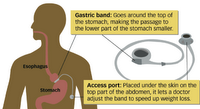Diabetes cure linked to lap band surgery

Columbia, MO
A year and a half ago, John Dorsey was suffering from obesity and Type 2 diabetes. He was taking 50 units of insulin, two oral antibiotics and another prescription drug every day to keep his blood sugar under control.gastric bypass and bariatric surgery malpractice lawsuits
He also weighed 406 pounds.
"If I hadn’t done something, I probably would have died," said Dorsey, 49, who works as a nurse in Cooper County.
So Dorsey had a medical procedure called Lap-Band surgery, where doctors insert a patented device to narrow the top of the stomach and forcibly reduce food intake. Within a month, Dorsey was no longer taking insulin, and within two months he was off all diabetes medication.
"I consider it a huge benefit," Dorsey said. "Losing weight helped me get rid of diabetes. I know it’s not going to work exactly the same for everybody. But for me, my blood sugar and high blood pressure were both related to my weight, so when I lost weight they fell back in line."
These days he says he’s 140 pounds lighter and his diabetes has vanished.
During each bariatric surgery, doctors insert a silicone band known as a Lap-Band to constrict the top of the patient’s stomach. After surgery, patients who previously ate large amounts report being full after meals of about 6 ounces. The size of the band can be increased or decreased as needed after surgery, and patients report being able to return to work in as little as two days.
The surgery is similar in its results to gastric bypass (sometimes known as stomach stapling), but proponents of the 45-minute Lap-Band procedure say it is less risky than the two-hour bypass surgery, which requires surgeons to staple a portion of the stomach closed and attach it to the small intestine. More >>

0 Comments:
Post a Comment
<< Home